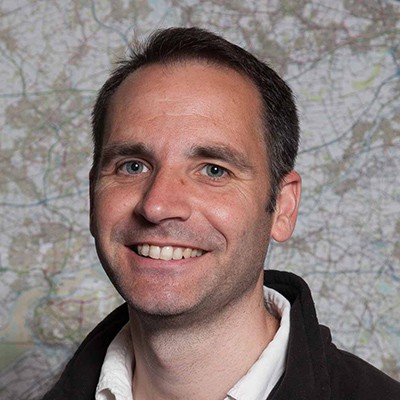Dr Graham Wilson
Senior Lecturer, Single Honours Geography Programme Leader and Department Research co-ordinator

I am a Physical Geographer with teaching and research interests in Environmental Change, specifically the analysis of diatom and stable isotopes in lake and estuarine sediment to investigate Late Quaternary climate and sea-level change.
Responsibilities
- Programme Leader, BSc Geography
Undergraduate teaching
- GE6001 Dissertation (Module Leader)
- GE6002 Independent Study (Module Leader)
- GE6017 Anthropocene (Module Leader)
- GE5012 Environmental Change (Module Leader)
- GE6005 Climate Change (co-delivery)
- GE4001 Introduction to Physical Geography and Geology (Tutor)
- GE4003 Foundations for Successful Studentship (Tutor)
- GE6015 Coastal Dynamics and Management (Tutor)
- GE6003 Natural Hazard Assessment and Mitigation (Tutor)
- GE5013/14 Researcher Development (Tutor)
Research Supervision
- Dale Tromans (2017-present). PhD topic - Holocene rapid climate events: a view from the Dinaric Alps. Lead supervisor.
Responsibilities
- Department Research co-ordinator
- REF UOA 14 co-ordinator
- Global Environmental Change and Hazard Management Research Group co-ordinator
Research interests
Current research focuses on (i) lake diatom and stable isotope records of climate change over orbital and millennial time scales; (ii) estuarine diatoms and stable isotopes as indicators of Holocene sea-level change and coastal evolution.
Funding
2021: NERC Environmental Isotope Facility. Holocene rapid climate change events in the Balkans (Radiocarbon allocation). G Wilson, D Tromans, M. Frogley, K. Welsh, M. Leng, Ascough, P.
2020: NERC Environmental Isotope Facility. Holocene rapid climate change events in the Balkans (δ18O, δ13C, δ15N, C/N analyses). M. Frogley, D Tromans, G Wilson, K. Welsh, M. Leng.
2016: Department QR Grant. Rapid climate changes in the Holocene: evidence from the Balkan Peninsula. G. Wilson, M. Frogley, P. Hughes.
2014: Department QR Grant. Terrestrial and lake hydrological response to millennial-scale climate oscillations during the penultimate glacial in southern Europe. G. Wilson, M. Frogley, T. Jones, P. Hughes, M. Leng.
2012: NERC Isotope Geosciences Facility. Investigating the spatial expression of millennial-scale Holocene climate changes in the sub-arctic (δ18O analysis of biogenic silica). G. Wilson, D. Fower, M. Leng.
2012: NERC Radiocarbon Allocation. G. Wilson, D. Fower, M. Leng.
2011: NERC Isotope Geosciences Facility. Allocation for δ13C and C/N analyses to investigate the spatial expression of millennial-scale Holocene climate changes in the sub-arctic. G. Wilson, D. Fower, M. Leng.
2011: INTERACT. Investigating the spatial expression of millennial-scale Holocene climate changes: a multi-proxy lake sediment approach, Finnish Lapland. D. Fower, G. Wilson.
2010: QRA Research Fund. Rapid climate changes in the Holocene: evidence from the Balkan Peninsula – pilot study. G. Wilson, M. Frogley.
2010: Department Research Grant (University of Portsmouth). Assessing the utility of diatom-based tidal level transfer functions. G. Wilson.
2001: NERC Isotope Geosciences Facility. Potential of bulk organic δ13C and C/N as Holocene sea-level indicators. A. Lamb, G. Wilson, M. Leng, J. Ridgway, F. Darbyshire, D. Huddart.
Wilson, G.P., Frogley, M.R., Hughes, P.D., Roucoux, K.H., Margari, V., Jones, T.D., Leng, M.J., Tzedakis, P.C. (2020). Persistent millennial-scale climate vatiability in Southern Europe during Marine Isotope Stage 6. Quaternary Science Advances 3. DOI.10.1016/j.qsa.2020.100016.
Wilson, G.P. (2017). On the application of contemporary bulk sediment organic carbon isotope and geochemical datasets for Holocene sea-level reconstruction in NW Europe. Geocheimica et Cosmochimica Acta 214, 191-208. DOI.10.1016/j.gca.2017.07.038.
Wilson, G.P., Reed, J.M., Frogley, M.R., Hughes, P.D., Tzedakis, P.C. (2015). Reconciling diverse lacustrine and terrestrial system response to penultimate. Geology 43, 818-822. DOI:10.1130/G36807.1.
Wilson, G.P., Frogley, M.R., Roucoux, K.H., Jones, T.D., Leng, M.J., Lawson, I.T., Hughes, P.D. (2013). Limnetic and terrestrial responses to climate change during the onset of the penultimate glacial stage in NW Greece. Global and Planetary Change 107, 213-225. DOI:10.1016/j.gloplacha.2013.05.015.
Inkpen, R.I., Wilson, G.P. (2013). Science, Philosophy and Physical Geography. Second Edition. Routledge: Oxon. ISBN: 978-0-415-67966-4.
Jones, T.D., Lawson, I.T., Reed, J.M., Wilson, G.P., Leng, M.J., Gierga, M., Bernasconi, S., Smittenberg, R., Hajdas, I., Bryant, C., Tzedakis, P.C. (2013). Diatom-inferred Late Pleistocene and Holocene palaeolimnological changes in the Ioannina basin, northwest Greece. Journal of Paleolimnology49, 185-204. DOI:10.1007/s10933-012-9654x.
Wilson, G.P., Lamb, A.L. (2012). An assessment of the utility of regional diatom-based tidal-level transfer functions. Journal of Quaternary Science 27, 360-370. DOI:10.1002/jqs.1553.
Inkpen, R., Wilson, G.P. (2009). Explaining the past: abductive and Bayesian reasoning. The Holocene 19, 329-334. DOI:10.1177/0959683608100577.
Wilson, G.P., Reed, J.M., Lawson, I.T., Frogley, M.R., Tzedakis, P.C., Preece, R.C. (2008). Diatom response to the last glacial-interglacial transition in the Ioannina basin, northwest Greece: Implications for Mediterranean palaeoclimate reconstruction. Quaternary Science Reviews 27, 428-440. DOI:10.1016/j.quascirev.2007.10.013.
Lamb, A.L., Vane, C.H., Wilson, G.P., Rees, J.G., Moss-Hayes, V.L. (2007). Assessing δ13C and C/N ratios from stored organic material as Holocene sea-level and palaeoenvironmental indicators in the Humber Estuary, UK. Marine Geology 244, 109-128. DOI:10.1016/j.margeo.2007.06.012.
Lamb, A.L., Wilson, G.P., Leng, M.J. (2006). A review of coastal palaeoclimate and relative sea-level reconstructions using δ13C and C/N ratios in organic material. Earth-Science Reviews 75, 29-57. DOI:10.1016/j.earscirev.2005.10.003.
Wilson, G., Lamb, A., Leng, M., Gonzalez, S., Huddart, D (2005). Variability of organic δ13C and C/N in the Mersey Estuary, U.K. and its implications for sea-level reconstruction studies. Estuarine, Coastal and Shelf Science 64, 685-698. DOI:10.1016/j.ecss.2005.04.003.
Wilson, G., Lamb, A., Leng, M., Gonzalez, S., Huddart, D (2005). δ13C and C/N as potential coastal palaeoenvironmental indicators in the Mersey Estuary, UK. Quaternary Science Reviews 24, 2015-2029. DOI:10.1016/j.quascirev.2004.11.014.
Wilson, G., Lamb, A., Gonzales, S., Leng, M., Huddart, D. (2004). The potential of carbon isotope ratios as indicators of coastal palaeoenvironmental change: preliminary results from the Mersey Estuary, North West England. In: R.C. Chiverrell, A.J. PLater, G.S.P. Thomas (eds.), The Quaternary of the Isle of Man and North West England: Field Guide, Quaternary Research Association, London, 217-225.
Wilson, G. (2002). Leash Fen. In: D. Huddart, N.F. Glasser (eds.), Quaternary of Northern England, Geological Conservation Review Series, No. 25, Joint Nature Conservation Committee, Peterborough, 493-499.
- PhD (LJMU)
- MSc (Liverpool)
- BSc (Liverpool)
- PgCLTHE (Portsmouth)
Professional Affiliations
- Quaternary Research Association
- European Geophysical Union
- Fellow of the Higher Education Academy